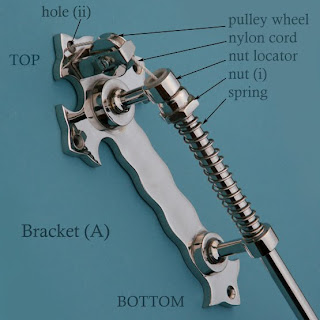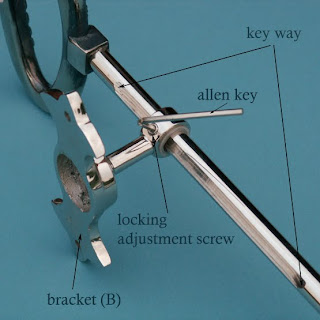Drill - 6, 8 and 10mm masonry drill bits - Scissors - Small hammer - Slotted screw driver - Spirit level - Small round file - Junior hacksaw
Before you start
1. Decide upon the height and location of your external Winchester Bell Pull and Internal Butlers Bell
2. The screws and wall plugs supplied are only suitable to use in solid walls. If fitting to other types of wall please source suitable fixings from your local hardware store.
3. Ensure there are no hidden service pipes or cables where you intend to drill.
4. The external fittings MUST be fitted first.
Fitting Instructions
Step 1 - Unscrew nut (i) located on the top of bell rod and remove bracket (A)
Step 2 - Mark the position of the four holes in bracket (A) on the brickwork
Step 3 - Hole (ii) in bracket (A) allows your bell cord to pass through the brickwork. Drill this hole using a 10mm drill bit. Step 4 - The remaining three holes are used for fixing bracket (A). Drill these with an 8mm bit to a depth two millimetres deeper than the length of the wall plugs provided. Tap the wall plugs into each of these holes. Before securing bracket (A) with the screws provided, pass the cord through the hole in the top of nut (i) and tie a knot in end (cutting off any excess) so the cord is now captive inside the nut. Continue to feed the loose end of the bell cord through the nut locator, over the pulley wheel, through the hole (ii) and the brickwork. When most of the cord has gone through the wall, wrap the remaining cord around the pulley wheel bracket at the top of the bell rod to stop it being pulled back through. Secure bracket (A).
Step 5 - Re-assemble the bell handle, spring and nut removed in Step 1.
Step 6 - Position bracket (B) approximately twelve millimetres above the square shoulder of the bell pull handle. Mark the location of the two fixing holes. Drill the holes using an 8mm bit. Plug and secure with screws provided.
Step 7 - Position bracket (C) mid-way between brackets (A) and (B) and repeat fixing procedure.
Step 8 - The brass tube supplied acts as a liner in the brickwork and helps protect the bell cord from dust. From inside the house, feed the cord through this tube and push it hard into the hole so it meets bracket (A). Mark the tube where it emerges from the wall. Remove the tube and cut it to length. Replace the tube ensuring that it sits flush with the inside of the wall and does not protrude
Step 9 - Thread the bell pull cord through the hole (iii) in blanking pulley (D). Place the blanking pulley in position over the hole, ensuring the wheel of the pulley is running in the right direction and that hole (iii) is central to the brass tube. Mark the position of the three fixing holes and drill with 6mm bit. Plug each hole and secure the pulley with the screws provided
If you order our Internal servants bell it is supplied with an extension pulley and directional pulley, extra pulleys are available as separate items.
There may be occasions that you want to lock your bell pull - may be when you go on holiday. You can do this by tightening the grub screw located on the side of 'Bracket B' (see in photo opposite) using the Allen key supplied but remember that adjusting the screw in or out will affect the smooth running of the rod.
Before you start
1. Decide upon the height and location of your external Winchester Bell Pull and Internal Butlers Bell
2. The screws and wall plugs supplied are only suitable to use in solid walls. If fitting to other types of wall please source suitable fixings from your local hardware store.
3. Ensure there are no hidden service pipes or cables where you intend to drill.
4. The external fittings MUST be fitted first.
Fitting Instructions
Step 1 - Unscrew nut (i) located on the top of bell rod and remove bracket (A)
Step 2 - Mark the position of the four holes in bracket (A) on the brickwork
Step 3 - Hole (ii) in bracket (A) allows your bell cord to pass through the brickwork. Drill this hole using a 10mm drill bit. Step 4 - The remaining three holes are used for fixing bracket (A). Drill these with an 8mm bit to a depth two millimetres deeper than the length of the wall plugs provided. Tap the wall plugs into each of these holes. Before securing bracket (A) with the screws provided, pass the cord through the hole in the top of nut (i) and tie a knot in end (cutting off any excess) so the cord is now captive inside the nut. Continue to feed the loose end of the bell cord through the nut locator, over the pulley wheel, through the hole (ii) and the brickwork. When most of the cord has gone through the wall, wrap the remaining cord around the pulley wheel bracket at the top of the bell rod to stop it being pulled back through. Secure bracket (A).
Step 5 - Re-assemble the bell handle, spring and nut removed in Step 1.
Step 6 - Position bracket (B) approximately twelve millimetres above the square shoulder of the bell pull handle. Mark the location of the two fixing holes. Drill the holes using an 8mm bit. Plug and secure with screws provided.
Step 7 - Position bracket (C) mid-way between brackets (A) and (B) and repeat fixing procedure.
Step 8 - The brass tube supplied acts as a liner in the brickwork and helps protect the bell cord from dust. From inside the house, feed the cord through this tube and push it hard into the hole so it meets bracket (A). Mark the tube where it emerges from the wall. Remove the tube and cut it to length. Replace the tube ensuring that it sits flush with the inside of the wall and does not protrude
Step 9 - Thread the bell pull cord through the hole (iii) in blanking pulley (D). Place the blanking pulley in position over the hole, ensuring the wheel of the pulley is running in the right direction and that hole (iii) is central to the brass tube. Mark the position of the three fixing holes and drill with 6mm bit. Plug each hole and secure the pulley with the screws provided
If you order our Internal servants bell it is supplied with an extension pulley and directional pulley, extra pulleys are available as separate items.
There may be occasions that you want to lock your bell pull - may be when you go on holiday. You can do this by tightening the grub screw located on the side of 'Bracket B' (see in photo opposite) using the Allen key supplied but remember that adjusting the screw in or out will affect the smooth running of the rod.




